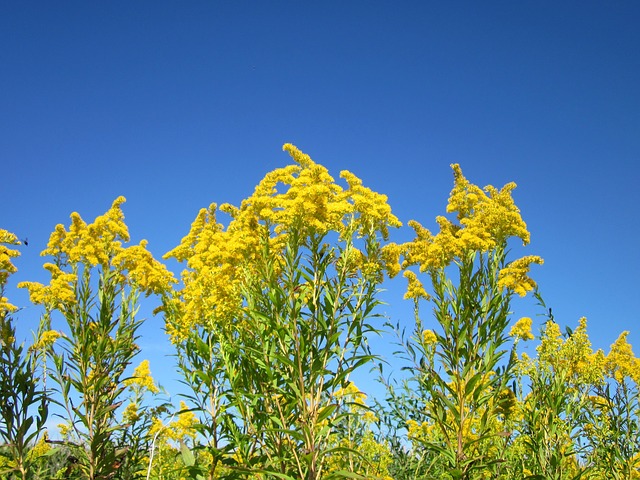 |  |  |  |  |
 |  |  |
Canadian goldenrod is a perennial plant that can grow up to 2m tall. It has a strong root system. Stems erect. Branched, woody at the base and densely leafy throughout their length. The leaves are lanceolate, pointed, arranged alternately, on which three veins are visible. The lower leaves are serrated with short petioles. The upper leaves are sessile with a smooth margin.
In the second year of the plant's life, the flowering period of the plant begins in the middle of summer and lasts for a month and a half. Dense, scaly inflorescences are formed at the ends of the stems. They consist of small, yellow flowers. At the end of August, cylindrical-shaped testes are formed - fruits with small brown seeds.
Canadian Goldenrod is a valuable honey plant. It is pollinated by wind and also reproduces vegetatively.
There are three species of goldenrod in Latvia: Canadian goldenrod (Solidago canadensis L.), Yellow goldenrod (Solidago virgaurea L.) and giant goldenrod (Solidago gigantea L.). The plant is cultivated for medicinal and decorative purposes. The most powerful, therapeutic effect is the Canadian goldenrod.
Unfortunately, the Canadian goldenrod is a very dangerous plant, as it forms a wide and dense root system, crowding out plants of other species from its growing environment. The influence of the Canadian Goldenrod on nature is close to that of Sosnovsky's hogweed. Canadian goldenrod is an invasive plant that is unwanted in many places and its stands are deliberately destroyed in the open.
The above-ground part of the Canadian goldenrod is used for medicinal purposes. The above-ground part of the plant begins to be harvested during its flowering. Inflorescences are chosen when they have not yet bloomed, because when they have bloomed, they will start to fall off, fluff up and shed seeds. The plant is dried in a well-ventilated and shady place or in forced dryers at a temperature not exceeding 40C.
Store in a breathable container, no longer than 2 years.
Canadian Goldenrod contains <0.12% flavonoids (quercetin, isoramentin, kaempferol, rutin), coumarins (umbelliferone, scopoletin), saponins, triterpene compounds, oxycinnamic acid, sugar, amino acids, essential oil, chlorophyll, amino acids, diterpenes, lipophilic substances.
Medicinal significance
In official medicine, the plant is considered a strong diuretic due to the active urine-repellant properties of saponins. Canadian Goldenrod raises the pH of urine, so there are restrictions on the use of this plant in the case of phosphate stones.
Canadian Goldenrod are effective in oxalate and urate stones. They are used in kidney disease, stone disease and bladder disease.
The flavonoids in the plant reduce the permeability of small blood vessels. Apart from the diuretic properties, the plant has a strong anti-inflammatory and antibacterial effect on the body. A beneficial effect has also been observed in the treatment of candidiasis, the active substances of the plant have a destructive effect on the yeast fungus candida .
In folk medicine, Canadian goldenrod is used both orally and externally as decoctions and poultices. Often, the yellow Goldenrod is used instead of the Canadian Goldenrod , but you should know that its effect is twice as weak.
Taking Canadian Goldenrod orally is useful for stomach disorders, gallstone disease, gout and rheumatism. Regular use of a decoction of the plant promotes the removal of stones from the urinary tract and kidneys, and also relieves spasmodic pain in the kidneys. The decoction is also used to rinse the mouth cavity for the treatment of bad breath and throat, in case of cold infections.
Decoctions of goldenrod leaves are used externally as compresses for the treatment of boils, cuts, festering and poorly healing wounds.
Essential oils of the plant are used in massages, applications and aroma lamps.
For men
In folk medicine, the plant is used on a par with yellow goldenrod, only it is twice as strong. In mixtures, it is used to treat prostate adenoma and chronic prostatitis.
Yellow goldenrod (Solidago virgaurea)
In mixtures, it is used to treat prostate adenoma, impotence, frequent pollution and chronic prostatitis.
